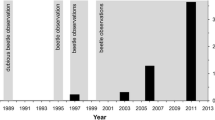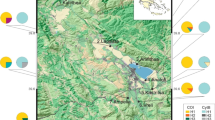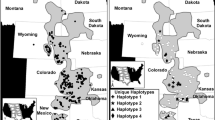Abstract
The fragmentation and destruction of natural habitats is one of the major causes of extinction of wild flora and fauna due to human activities. The area around the Mediterranean Basin is particularly affected: this region is one of the world’s richest in terms of biodiversity and is undergoing substantial modification due to extensive changes in land use. We investigated the demographic state (through a genetic survey) of an endangered grasshopper, the geographical distribution of which is restricted to arid open land or glades in south-eastern France. We compared two subspecies: one is severely threatened by the fragmentation of its specific and restricted habitat (Prionotropis hystrix rhodanica in the ‘Crau’ steppe) whereas the other, P.␣h.␣azami, occurs more widely in glades or clearings in the evergreen Mediterranean forest. Genetic diversity at eight microsatellite loci was highly structured, indicating substantial isolation of populations. Within-population diversity was high at all but one site. Genetic drift was the major force involved in this genetic structure, with very little gene flow at the regional scale of observation, consistent with both the limited dispersal of this flightless species and the patchy configuration of its habitat. No significant differences in the extent of genetic diversity or population dynamics were observed between the two subspecies. The observed genetic pattern calls into question the validity of the subspecies status, and shows no strong impact of recent anthropogenic modification of the Crau steppe. The evolution of the Mediterranean xeric and open habitats under both natural and anthropogenic processes is discussed.
Similar content being viewed by others
References
Adams JM, Faure H (1997) Preliminary vegetation maps of the world since the last glacial maximum: An aid to archaeological understanding. Journal of Archaeological Science 24: 623–647
Balletto E, Casale A (1991) Mediterranean insect conservation. In: Collins NM, Thomas JA (eds), The conservation of insects and their habitats. Academic Press, London, pp. 121–142
Bellmann H, Luquet G (1995) Guide des sauterelles, grillons et criquets d’Europe occidentale. Delachaux et Niestlé, Lausanne
Blondel J, Aronson J (1999) Biology and Wildlife of the Mediterranean region. Oxford University Press, Oxford
Castric V, Bernatchez L, Belkhir K, Bonhomme F (2002) Heterozygote deficiencies in small lacustrine populations of brook charr Salvelinus Fontinalis Mitchill (Pisces, Salmonidae): a test of alternative hypotheses. Heredity 89: 27–35
Cheylan G (1975) Esquisse écologique d’une zone semi aride : La Crau (Bouches du Rhône). Alauda 43: 23–54
Ciofi C, Beaumont MA, Swingland IR, Bruford MW (1999) Genetic divergence and units for conservation in the Komodo dragon Varanus komodoensis. Proceedings of the Royal Society of London Series B-Biological Sciences 266: 2269–2274
Delmas R, Rambier A (1950) Notes orthoptérologiques. Bulletin de la Société Entomologique de France 29: 35–40
Defaut B (2001) Actualisation taxonomique et nomenclature du“synospis des orthoptères de France”. Matériaux Entomocénotiques 6: 107–112
Devaux JP, Archiloque A, Borel L, Bourrely M, Louis-Palluel J (1983) Notice de la carte phyto-écologique de la Crau (Bouches-du-Rhône). Biologie-Ecologie Méditéranéenne 10: 5–54
Doligez A, Baril C, Joly HI (1998) Fine-scale spatial genetic structure with nonuniform distribution of individuals. Genetics 148: 905–919
Don RH, Cox PT, Wainwright BJ, Baker K, Mattick JS (1991) ‘Touchdown’ PCR to circumvent spurious priming during gene amplification. Nucleic Acids Res 19: 4008
Elenga H, Peyron O, Bonnefille R, et al. (2000) Pollen-based biome reconstruction for southern Europe and Africa 18,000 yr BP. J Biogeography 27: 621–634
Ellegren H, Moore S, Robinson N, et al. (1997) Microsatellite evolution–A reciprocal study of repeat lengths at homologous loci in cattle and sheep. Mol Biol Evol 14: 854–860
Fahrig L (2002) Effect of habitat fragmentation on the extinction threshold: A synthesis. Ecological Applications 12: 346–353
Foucart A (1995) Prionotropis rhodanica Uvarov, 1923 [Acridoidea, Pamphagidae, Akicerinae], acridien protégé de la Crau (Bouches-du-Rhône, France). Mémoire, Ecole Pratique des Hautes Etudes
Foucart A, Lecoq M (1996) Biologie et dynamique de Prionotropis hystrix rhodanica Uvarov, 1923, dans la plaine de la Crau (France) (Orthoptera, Pamphagidae). Bulletin de la Société Entomologique de France 101: 75–87
Foucart A, Lecoq M, Sieglstetter R (1999) Alarm on an endemic protected grasshopper of the Crau plain (Southern France), Prionotropis hystrix rhodanica (Orthoptera : Pamphagidae). Annales de La Société Entomologique De France 35: 337–340
Frankham R, Ballou JD, Briscoe DA (2002) Introduction to Conservation Genetics. Cambridge University Press, Cambridge
Gaines MS, Diffendorfer JE, Tamarin RH, Whittam TS (1997) The effects of habitat fragmentation on the genetic structure of small mammal populations. Journal of Heredity 88: 294–304
Galbusera P, Githiru M, Lens L, Matthysen E (2004) Genetic equilibrium despite habitat fragmentation in an Afrotropical bird. Molecular Ecology 13:1409–1421
Gerber AS, Templeton AR (1996) Population sizes and within-dome movement of Trimerotropis saxatilis (Acrididae), a grasshopper with a fragmented distribution. Oecologia 105: 343–350
Gutzwiller KJ (2002) Applying landscape ecology in biological conservation. Springer-Verlag, New York
Heller KG, Korsunovskaya O, Ragge D-R, Vedenina D-R, Willemse F, Zhantiev R-D, Frantsevich L (1998) Check-List of European Orthoptera. Articulata 7:1–61
Jalut G, Amat AE, Bonnet L, Gauquelin T, Fontugne M (2000) Holocene climatic changes in the Western Mediterranean, from south-east France to south-east Spain. Palaeogeography Palaeoclimatology Palaeoecology 160: 255–290
Knutsen H, Rukke BA, Jorde PE, Ims RA (2000) Genetic differentiation among populations of the beetle Bolitophagus reticulatus (Coleoptera: Tenebrionidae) in a fragmented and a continuous landscape. Heredity 84: 667–676
Kruseman G (1982) Matériaux pour la faunistique des Orthoptères de France. Fasc. II. Les acridiens des musées de Paris et d’Amsterdam, 36, Instituut voor Taxonomische Zoölogie, Zoologisch Museum, Universiteit van Amsterdam.
Labaune C, Magnin F (2002) Pastoral management vs. land abandonment in Mediterranean uplands: impact on land snail communities. Global Ecol Biogeography 11: 237–245
Lande R (1999) Extinction risks from anthropogenic, ecological, and genetic factors. In: Landweber LF, Dobson AP (eds) Genetics and the Extinction of Species. Princeton University Press, Princeton, pp. 1–22
Loader CR (1996) Local likelihood density estimation. Annals of Statistics 24: 1602–1618
Mennechez G, Schtickzelle N, Baguette M (2003) Metapopulation dynamics of the bog fritillary butterfly: comparison of demographic parameters and dispersal between a continuous and a highly fragmented landscape. Landscape Ecology 18: 279–291
Myers N, Mittermeier RA, Mittermeier CG, da Fonseca GA, Kent J (2000) Biodiversity hotspots for conservation priorities. Nature 403: 853–858
Nei M, Tajima F, Tateno Y (1983) Accuracy of estimated phylogenetic trees from molecular data. Journal of Molecular Evolution 19: 153–170
Peacock MM, Smith AT (1997) The effect of habitat fragmentation on dispersal patterns, mating behaviour, and genetic variation in a pika (Ochotona princeps) metapopulation. Oecologia 112: 524–533
Piry S, Luikart G, Cornuet J-M (1999). BOTTLENECK: a computer program for detecting recent reductions in the effective population size using allele frequency data. Journal of Heredity 90: 502–503
Presa JJ, Llorente V (1982) Los Pamphagidae de la Peninsula Iberica. 1. Gen. Prionotropis Fieb. y Acinipes Ramb. (Orthoptera). Eos, Revista Española de Entomologìa, Madrid 58: 271–302
Pritchard JK, Stephens M, Donnelly P (2000) Inference of population structure using multilocus genotype data. Genetics 155: 945–959
Raymond M, Rousset F (1995) GENEPOP (Version 1.2): Population genetics software for exact tests and eucumenism. Journal of Heredity 86: 248–249
Romermann C, Dutoit T, Poschlod P, Buisson E (2005) Influence of former cultivation on the unique Mediterranean steppe of France and consequences for conservation management. Biological Conservation 121: 21–33
Sambrook J, Fritsch E, Maniatis T (1989) Molecular cloning: a Laboratory Manual. Cold Spring Harbor Laboratory Press, New York
Saunders DA, Hobbs RJ, Margules CR (1991). Biological consequences of ecosystem fragmentation: a review. Conservation Biology 5: 18–32
Streiff R, Mondor-Genson G, Audiot P, Rasplus J-Y (2002). Microsatellite DNA markers for a grasshopper: Prionotropis hystrix rhodanica (Orthoptera, Pamphagidae). Molecular Ecology Notes 2: 265–267
Taberlet P, Fumagalli L, Wust-Saucy AG, Cosson JF (1998) Comparative phylogeography and postglacial colonization routes in Europe. Molecular Ecology 7: 453–464
Takezaki N, Nei M (1996) Genetic distances and reconstruction of phylogenetic trees from microsatellite DNA. Genetics 144: 389–399
Thomas CD (2000) Dispersal and extinction in fragmented landscapes. Proceedings of the Royal Society of London, Series B, Biological Sciences 267: 139–145
Uvarov BP (1943) The tribe Trinchini of the subfamily Pamphaginae, and the interrelations of the acridid subfamilies (Orthoptera). Transactions of the Royal Entomological Society of London 93:1–72
Williams BL, Brawn JD, Paige KN (2003). Landscape scale genetic effects of habitat fragmentation on a high-gene flow species: Speyeria idalia (Nymphalidae). Molecular Ecology 12: 11–20
Wolff A, Dieuleveut T, Martin J-L, Bretagnolle V (2002). Landscape context and little bustard abundance in a fragmented steppe: implications for reserve management in mosaic landscapes. Biological Conservation 107: 211–220
Wolff A, Paul JP, Martin JL, Bretagnolle V (2001). The benefits of extensive agriculture to birds: the case of the little bustard. Journal of Applied Ecology 38: 963–975
Acknowledgements
This work was supported by funding from: The French Institute for Biodiversity (IFB), the French Ministry for Territory Management and Environment (MATE), and the National Institute of Agronomic Research (INRA). We thank the ‘Conservatoire –Etudes des Ecosystemes de Provence’ (CEEP) for help with sampling.
Author information
Authors and Affiliations
Corresponding author
Rights and permissions
About this article
Cite this article
Streiff, R., Audiot, P., Foucart, A. et al. Genetic survey of two endangered grasshopper subspecies, Prionotropis hystrix rhodanica and Prionotropis hystrix azami (Orthoptera, Pamphagidae): within- and between-population dynamics at the regional scale. Conserv Genet 7, 331–344 (2006). https://doi.org/10.1007/s10592-005-9043-3
Received:
Accepted:
Published:
Issue Date:
DOI: https://doi.org/10.1007/s10592-005-9043-3




